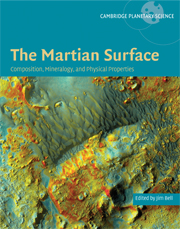Book contents
- Frontmatter
- Contents
- List of contributors
- Foreword
- Acknowledgments
- Part I Introduction and historical perspective
- Part II Elemental Composition: Orbital and in situ Surface Measurements
- Part III Mineralogy and Remote Sensing of Rocks, Soil, Dust, and Ices
- 7 Mineralogy of the Martian surface from Mars Express OMEGA observations
- 8 Visible to near-IR multispectral orbital observations of Mars
- 9 Global mineralogy mapped from the Mars Global Surveyor Thermal Emission Spectrometer
- 10 The compositional diversity and physical properties mapped from the Mars Odyssey Thermal Emission Imaging System
- 11 Mars' crustal magnetization: a window into the past
- 12 Multispectral imaging from Mars Pathfinder
- 13 Mars Exploration Rover Pancam multispectral imaging of rocks, soils, and dust at Gusev crater and Meridiani Planum
- 14 The mineralogy of Gusev crater and Meridiani Planum derived from the Miniature Thermal Emission Spectrometers on the Spirit and Opportunity rovers
- 15 Iron mineralogy and aqueous alteration on Mars from the MER Mössbauer spectrometers
- 16 Magnetic properties of Martian surface materials
- 17 Martian meteorites as crustal samples
- Part IV Physical Properties of Surface Materials
- Part V Synthesis
- Part VI Summary, Upcoming Missions, and New Measurement Needs
- Index
- Plate section
- References
12 - Multispectral imaging from Mars Pathfinder
from Part III - Mineralogy and Remote Sensing of Rocks, Soil, Dust, and Ices
Published online by Cambridge University Press: 10 December 2009
- Frontmatter
- Contents
- List of contributors
- Foreword
- Acknowledgments
- Part I Introduction and historical perspective
- Part II Elemental Composition: Orbital and in situ Surface Measurements
- Part III Mineralogy and Remote Sensing of Rocks, Soil, Dust, and Ices
- 7 Mineralogy of the Martian surface from Mars Express OMEGA observations
- 8 Visible to near-IR multispectral orbital observations of Mars
- 9 Global mineralogy mapped from the Mars Global Surveyor Thermal Emission Spectrometer
- 10 The compositional diversity and physical properties mapped from the Mars Odyssey Thermal Emission Imaging System
- 11 Mars' crustal magnetization: a window into the past
- 12 Multispectral imaging from Mars Pathfinder
- 13 Mars Exploration Rover Pancam multispectral imaging of rocks, soils, and dust at Gusev crater and Meridiani Planum
- 14 The mineralogy of Gusev crater and Meridiani Planum derived from the Miniature Thermal Emission Spectrometers on the Spirit and Opportunity rovers
- 15 Iron mineralogy and aqueous alteration on Mars from the MER Mössbauer spectrometers
- 16 Magnetic properties of Martian surface materials
- 17 Martian meteorites as crustal samples
- Part IV Physical Properties of Surface Materials
- Part V Synthesis
- Part VI Summary, Upcoming Missions, and New Measurement Needs
- Index
- Plate section
- References
Summary
ABSTRACT
The Imager for Mars Pathfinder (IMP) was a mast-mounted instrument on the Mars Pathfinder (MPF) lander which landed on Mars' Ares Vallis floodplain on July 4, 1997. During the 83 sols of MPF landed operations, the IMP collected over 16 600 images. Multispectral images were collected using 12 narrowband filters at wavelengths between 400 and 1000 nm in the visible and near-infrared (VNIR) range. The IMP provided VNIR spectra of the materials surrounding the lander including rocks, bright soils, dark soils, and atmospheric observations. During the primary mission, only a single primary rock spectral class, “Gray Rock,” was recognized; since then, “Black Rock” has been identified. The Black Rock spectra have a stronger absorption at longer wavelengths than do Gray Rock spectra. A number of coated rocks have also been described, the Red and Maroon Rock classes, and perhaps indurated soils in the form of the Pink Rock class. A number of different soil types were also recognized with the primary ones being Bright Red Drift, Dark Soil, Brown Soil, and Disturbed Soil. Examination of spectral parameter plots indicated two trends which were interpreted as representing alteration products formed in at least two different environmental epochs of the Ares Vallis area. Subsequent analysis of the data and comparison with terrestrial analogs have supported the interpretation that the rock coatings provide evidence of earlier Martian environments.
- Type
- Chapter
- Information
- The Martian SurfaceComposition, Mineralogy and Physical Properties, pp. 263 - 280Publisher: Cambridge University PressPrint publication year: 2008
References
- 7
- Cited by

